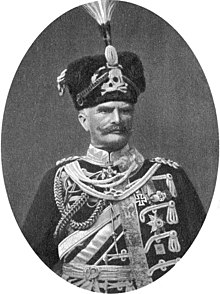August von Mackensen
During the Nazi era (1933–1945), Mackensen remained a committed monarchist and sometimes appeared at official functions in his World War I uniform.
During the Franco-Prussian War of 1870–1871, he was promoted to second lieutenant and won the Iron Cross Second Class for leading a charge on a reconnaissance patrol north of Orléans.
[6] Mackensen was recalled from the regiment to serve as an adjutant to the next chief, Alfred von Schlieffen (in office 1891–1906), whom he regarded as a great instructor on how to lead armies of millions.
For the next three-and-a-half years, he shadowed the Kaiser and met the high and mighty of Germany, the rest of Europe and the Middle East.
[11] The Crown Prince was placed under his command, and the Kaiser asked Mackensen to keep an eye on the young man and to teach him to ride properly.
Mackensen had his corps moving out on a 25 km march to the Rominte River within fifty minutes of receiving his orders on the afternoon of 19 August 1914, after the Imperial Russian Army had invaded East Prussia.
On 27 November 1914, Mackensen was awarded the Pour le Mérite, Prussia's highest military order, for successful battles around Warsaw and Łódź.
As chief of staff, he was assigned Hans von Seeckt, who described Mackensen as an amiable, "hands-on commander with the instincts of a hunter".
[15] The joint operation was a great victory for the Central Powers, which advanced 310 km (186 mi), and the Russians pulled out of all of Poland soon afterward.
The campaign crushed effective military resistance in Serbia but failed to destroy the Royal Serbian Army, half of which managed to retreat to Entente-held ports in Albania and, after recuperation and rearmament by the French and the Italians, re-entered fighting on the Macedonian front.
When Mackensen returned to Vienna, he was honoured by a dinner and a personal audience with Emperor Franz Joseph I of Austria and was decorated with the magnificently jeweled Military Merit Cross 1st Class with Diamonds, a unique award for a foreigner.
[16]After Romania declared war on Austria-Hungary on 15 August 1916, Mackensen was given command of a multinational army, with General Emil von Hell as chief of staff, of Bulgarians, Ottomans, Austro-Hungarians and Germans.
By 8 September, it had taken the two major forts on the right bank of the Danube, the first in a single day by a force that was outnumbered by the besieged, who were overwhelmed by Mackensen's artillery.
Mackensen maintained that he had never been defeated in battle, and he surely was the most consistently successful senior general on either side in World War I.
Although standing in opposition to the conclusion of the Treaty of Versailles and the newly established parliamentary system of the Weimar Republic, he initially avoided public campaigns.
He became very active in pro-military Conservative Revolutionary movement organisations, particularly Der Stahlhelm and the Schlieffen Society, which advocated the stab-in-the-back myth and openly endorsed the murder of Minister Matthias Erzberger in 1921.
During the German presidential election of 1932, Mackensen supported Paul von Hindenburg against Adolf Hitler, whose political skills he nevertheless admired.
A striking visual icon of the Prussian traditions adopted by Hitler's regime, he appeared in his black uniform and death's-head busby at public events organized by the German government or the Nazi Party such as the Day of Potsdam on 21 March 1933.
[citation needed] His letter demanded that von Hindenburg punish the responsible parties and create a directorate to rule Germany.
He started a campaign to have von Schleicher rehabilitated by Hitler and, when this gathered strength and succeeded, spoke about the murders at the annual General Staff Society meeting in February 1935.
[26] His fame and familiar uniform gave rise to two separate Third Reich units adopting black dress with Totenkopf badges: the Panzerwaffe, which claimed the tradition of the Imperial Cavalry, and the Schutzstaffel.
On 4 February 1940, Mackensen wrote to then Generaloberst Walther von Brauchitsch: As a man becomes older, he has to watch carefully that age has not reduced his creativity.
The concern results from the crimes committed in Poland, looting and murder that take place before the eyes of our troops, who appear unable to put an end to them.
These lines intend to convey my daily growing concern at the reports that constantly reach me, and I have to ask you to take up this matter with the highest authority.
[28] Mackensen remained a committed monarchist and in June 1941 appeared in full imperial uniform at Kaiser Wilhelm's funeral at Doorn, in the Netherlands.
Upon the arrival of the British, not commenting on the general rout, the 95-year-old Mackensen merely asked the new powers-that-be that "freed foreign workers" be prevented "from stealing his chickens".







